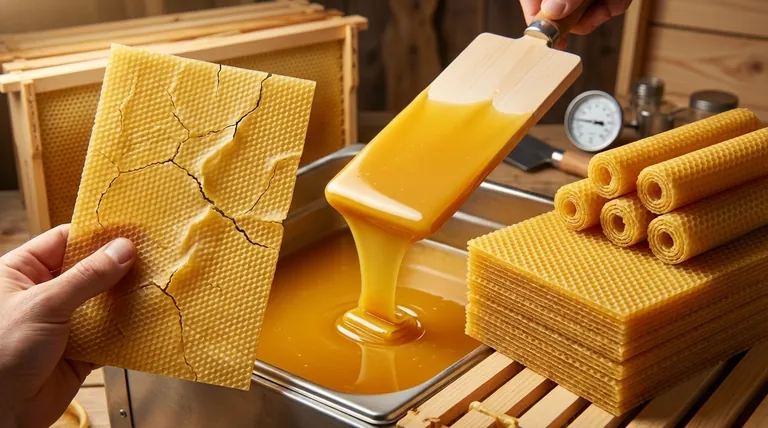Improper management of the wax dipping process directly leads to structurally flawed foundation sheets. The most common issues are ripples, cracks, poor adhesion, and non-uniform thickness, all of which compromise the final product's quality and usability for a bee colony.
Success in creating wax foundation sheets is not about a single action, but about mastering the interplay between wax temperature, cooling rate, and physical technique. A failure in one variable will cascade, undermining the structural integrity of the final sheet.

The Critical Role of Temperature
Temperature is the single most important variable in this process. Both the wax temperature and the rate at which it cools dictate the sheet's fundamental characteristics.
When the Wax is Too Cold
If the wax temperature is too low, its viscosity increases. This thicker, slower-moving liquid will not flow smoothly over the dipping board.
This lack of flow creates ripples or waves on the surface of the sheet. The result is an irregular foundation with inconsistent thickness, which can be problematic for bees.
When the Wax Cools Too Quickly
Dipping the hot board into a cold water vat creates thermal shock. If this cooling process is too rapid, the wax is put under immense stress.
This stress is released through cracking, creating fractures throughout the sheet and rendering it useless. The wax contracts too fast for its structure to remain intact.
The Importance of Physical Technique
How you handle the dipping board is just as crucial as managing the temperature. Your physical actions directly influence adhesion and uniformity.
The Impact of Insertion Speed and Angle
The dipping board must be inserted into the molten wax smoothly and deliberately. A blunt or overly fast insertion can prevent the new layer of wax from bonding properly to the previous one.
This poor adhesion can cause the layers to separate, sometimes described as the sheet "exploding" or ripping apart as it's handled.
Ensuring Uniformity During Draining
After the board is removed from the wax, it must be held perfectly straight and still while the excess wax drains off.
If the board is tilted, gravity will cause the liquid wax to flow unevenly to one side. This creates a sheet that is thick on one end and thin on the other, lacking the uniform structure required.
Understanding the Common Pitfalls
Achieving a perfect sheet requires avoiding common mistakes that seem minor but have significant consequences.
Rushing the Process
The most frequent error is a lack of patience. Dipping too fast causes delamination, and cooling too quickly causes cracks. The process demands a slow, methodical pace.
Inconsistent Technique
Each dip must be a repeat of the last. Varying your insertion speed, angle, or draining position from one sheet to the next will produce inconsistent and unpredictable results.
Ignoring Environmental Factors
The ambient temperature of your workspace can affect the cooling rate of both the wax vat and the water bath. A process that works perfectly on a warm day may need adjustment on a cold one to prevent the wax from cooling too fast.
Making the Right Choice for Your Goal
To diagnose and fix your process, focus on the specific type of flaw you are seeing.
- If your primary focus is eliminating cracks and ripples: Your problem is temperature. Ensure your wax is hot enough to flow smoothly and your water bath isn't so cold that it causes thermal shock.
- If your primary focus is preventing delamination or tearing: Your problem is technique. Slow down your insertion speed and ensure a smooth entry into the wax.
- If your primary focus is achieving uniform thickness: Your problem is stability. Hold the board perfectly level and still during the draining phase after each dip.
By mastering these fundamental variables, you gain precise control over the quality and consistency of your foundation sheets.
Summary Table:
| Problem Symptom | Likely Cause | Primary Solution |
|---|---|---|
| Cracks | Wax cooling too quickly (thermal shock) | Adjust water bath temperature to prevent rapid cooling |
| Ripples/Waves | Wax temperature too low (high viscosity) | Increase wax temperature for smoother flow |
| Delamination/Tearing | Incorrect insertion speed/angle (poor adhesion) | Slow down and smooth out board entry into wax |
| Non-uniform Thickness | Board tilted during draining | Hold board perfectly level and still while draining |
Produce Perfect Foundation Sheets Every Time
Are cracks, ripples, and inconsistent thickness affecting your foundation quality? HONESTBEE supplies beekeeping supplies and equipment—including high-quality wax and reliable dipping equipment—to commercial apiaries and beekeeping equipment distributors. Our wholesale-focused operations ensure you get the durable, consistent materials needed to master the wax dipping process.
Let us help you eliminate production flaws and achieve superior, uniform sheets for healthier, more productive colonies.
Contact HONESTBEE today for expert advice and wholesale pricing on the supplies you need to succeed.
Visual Guide

Related Products
- Beeswax Foundation Sheets Beehive Foundation for Wholesale
- Notebook Style Beeswax Foundation Mould Wax Foundation Mold
- Manual Beeswax Comb Foundation Machine Wax Foundation Mill Embossing Machine
- Colorful Silicone Beeswax Foundation Mold Mould for Beekeeping
- Food Grade Plastic bee Foundation for Bee Frames
People Also Ask
- What happens if foundation is given to colonies during a nectar dearth? Avoid Wasted Equipment and Stressed Bees
- How do beeswax foundations save bees time and energy? Boost Hive Productivity & Honey Yield
- What are the characteristics of beeswax foundation? A Natural Choice for Healthy Hives
- What is beeswax foundation used for? A Guide to Efficient Hive Management
- What are the sizes of natural worker and drone cells? Guide to Natural Beehive Architecture



















